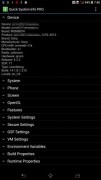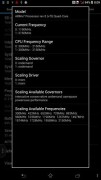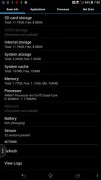Is the Sony Xperia Z Ultra phablet a better alternative to the Xperia Z?
Sony’s Xperia Z re-defined the company’s design style and even introduced a new interface overlay for Android. It’s a 5-inch smartphone with a Full HD 1080p display, quad-core processor and a waterproof chassis.
The Xperia Z Ultra build on the Xperia Z with a larger form factor, a bigger display packed with new technology and a high-end Snapdragon 800 chip.
Sony Xperia Z: Key specs and features
The Xperia Z was the first phone to introduce a new design ethos at Sony. Not only does it feature a highly angular shape with some interestingly detailing and premium finish materials, but it’s also IP57 certified for water and dust resistance and is waterproof up to a depth of one metre.
The exterior design is rewarding to look at thanks to the Dragontrail glass front and back – which also offers extreme durability – sharply contoured corners, silver trim, matte finish polycarbonates and panelled detailing along the neatly shaped edges.
Picking up the phone is no less pleasing an experience, everything fits together nicely with a solid feel and materials which are suitably premium to the touch. It’s thin at 7.9mm and reasonably lightweight at 146g.
The Xperia Z is a very nippy device in terms of speed and performance thanks to a quad-core Qualcomm Snapdragon S4 Pro processor chip clocked at 1.5GHz with an Adreno 320 graphics processing unit (GPU) and 2GB of RAM. Android 4.2 is well-optimised here and the Sony UI works smoothly. You’ll get no lag while transitioning between screens and you can rest assured even the most demanding content on Google Play will run well with a wealth of choice from Google’s ecosystem too.
Sony continues to impress with its display technology. The 5-inch touchscreen packs a 1920x1080 pixel Full HD resolution at a super-sharp 440 pixels-per-inch (ppi) pixel density and is also powered by Sony’s Mobile Bravia Engine 2 for enhanced colour, contrast and clarity. It’s a phenomenal screen to behold with a highly cinematic almost 3D-like experience, making it ideal for watching feature length films, TV shows, YouTube clips in HD quality and flashy 3D games.
For connectivity the Xperia Z is well-stacked with 4G LTE, NFC, MHL TV-out, Wi-Fi, Bluetooth, DLNA and GPS. A microSD slot allows storage to be expanded by up to 64GB.
The onboard camera is a very competitive setup as it uses a 13-megapixel Sony Exmor RS sensor with an LED flash, HDR, panoramic capture, digitals stabilisation and 1080p video capture. A 2.2-megapixel secondary also provides decent self portraits and 1080p video calls.
Sony Xperia Z Ultra: Key specs and features
The Xperia Z Ultra is bigger than the Xperia Z in every sense of the word. While the form factor has been enlarged to accommodate a 6.44-inch display there’s very little about the exterior that’s changed. But, this is a very good thing, as mentioned above the Xperia Z’s styling, build and design are all top notch and combine to form a very slick product. The panelled detailing, glass front and back, silver trim and angular, thin shape all make a welcome return here. So too does the IP certification for dust and water resistance and waterproofing, this time bumped up to IP58 and without the need for fiddly port covers, though it’s still only good for up to a metre of water.
The larger 6.44-inch display sports the same 1920x1080 pixel resolution, which results in a slightly lower pixel density of around 342ppi, but this is still incredibly impressive for a screen of this size and you’d probably find it difficult to tell the difference.
It also benefits from some additional enhancements. All of the Xperia Z’s positives are here – enhanced colour, contrast, brightness, white purity and clarity, but they’re boosted even further by Sony’s advancement of these technologies. Instead of the Mobile Bravia Engine 2, Sony has tweaked things to look even better with what it’s now calling the X-Reality Engine. Equally as significant is the use of Triluminos display technology which creates more natural colours.
As well as a display upgrade the Xperia Z Ultra also packs a significantly boosted processor setup and it’s the first handset to be launched packing Qualcomm’s Snapdragon 800 quad-core processor clocked at a staggering 2.2GHz with an Adreno 330 GPU and 2GB of RAM. At present you won’t find a faster smartphone anywhere else.
Also of note is the fact that the Xperia Z Ultra supports stylus input. It does not come with a stylus, but supports third party pokey sticks and even will allow the use of a pencil, pen or other similar implement. This means it doesn’t use a digitiser and therefore can’t do things like adjust line thickness based on pressure, but for basic note taking and diagrams this is no real issue.
Lastly, the Xperia Z Ultra has a very large battery pack rated at 3,050mAh, ensuring that you should be able to go for at least a day and a bit on one charge.
Direct spec comparison: Shootout
| Device | Sony Xperia Z | Sony Xperia Z Ultra |
| Dimensions | 139x71x7.9mm, 146g | 179.4x92.2x6.5mm, 212g |
| Display | 5-inch LCD,1920x1080 pixels,440ppi | 6.44-inch Triluminos LCD,1920x1080 pixels,342ppi, X-Reality Engine |
| Camera | 13-megapixel Exmor RS,LED flash,1080p video | 8-megapixel Exmor RS,LED flash,1080p video |
| Storage | 16GB,microSD up to 64GB | 16GB,microSD up to 64GB |
| Processor, RAM, Graphics | 1.5GHz quad-core Qualcomm Snapdragon S4,2GB RAM, Adreno 320 GPU | 2.2GHz quad-core Qualcomm Snapdragon 800,2GB RAM,Adreno 330 GPU |
| Operating System, | Android 4.2 Jelly Bean | Android 4.2 Jelly Bean |
| UI | Sony UI | Sony UI |
| Connectivity | microUSB,Bluetooth,NFC,Wi-Fi,Wi-Fi Direct,Wi-Fi Hotspot,DLNA,4G,GPS,MHL | microUSB,Bluetooth,NFC,Wi-Fi,Wi-Fi Direct,Wi-Fi Hotspot,DLNA,4G,GPS,MHL |
| Battery | 2,330mAh | 3,050mAh |
Points to consider: Practical use
The Xperia Z is a big phone, but 5-inches seems to have become an acceptable standard for flagships and it’s nowhere near the enormous size of the Xperia Z Ultra’s 6.44-inches. Although the Xperia Z Ultra is offering much more lovely screen real-estate to tantalise the eyeballs and make stuff like web browsing very enjoyable it may have crossed a threshold in terms of what’s a convenient scale for a phone.
Naturally in terms of build quality and design both handsets are on a par here as Sony has implemented the same ethos throughout. Likewise, both are equally well-equipped for connectivity options and both internal storage (16GB all round) and expansion via microSD cards.
The Qualcomm Snapdragon 800 processor nestling inside the Xperia Z Ultra does tip the balance somewhat as it’s considerably more powerful than what the Xperia Z uses. But, with that said, you’ll find that both setups are packing more power than you currently need to run Android Jelly Bean, the Sony UI and any apps on Google Play with fast and fluid performance. The Xperia Z Ultra will remain competitive for longer though if future-proofing is a priority for you.
Battery life is very important when looking at these two devices. The Xperia Z does not have particularly good battery life as the excellent display and fast processor do take their toll on the 2,330mAh unit.
It remains to be seen how well the Xperia Z Ultra’s 3,050mAh setup fares, it should do better in theory, but we note that the Xperia Z Ultra has a larger display with more complex technology layers while the processor is more fearsome too. Potentially the processor could be more efficient, but I can’t say for sure just yet and if the increased spec in these areas really does impact on things significantly then the increase battery power might be nullified somewhat.
The display is a tough one to call. The Xperia Z has one of the best smartphone displays I’ve ever seen and the Xperia Z Ultra provides a larger touchscreen with enhanced iterations of the same technology which makes it so amazing, but at a loss of about 100ppi. Both are still well over the 300ppi threshold which makes things look nice and sharp though. In all honesty I think in this bracket quibbling over the pixel density and resultant sharpness is probably a moot point, but what remains unclear is if the use of the X-Reality Engine and Triluminos tech makes that much of a difference.
Conclusion
The Sony Xperia Z Ultra is more up-to-date in terms of processor and display hardware, but aside from future-proofing it’s difficult to see what the advantages really are. If you’re after a huge display then of course you’ll do well with the Xperia Z Ultra but it will be more unwieldy in the hand. The main appeal for me is the increased battery size as the only thing putting me off the Xperia Z when it released was the poor battery life. But while the battery might be improved and the Xperia Z Ultra carries more clout in the engine bay I’m still not entirely onboard with a phone of this size when 5-inch screens serve perfectly well. Personally, I’m waiting to see what the Xperia i1 Honami is like as it sounds like it’ll introduce all the same boosts to hardware at the 5-inch scale.
Source: Knowyourmobile
on Friday, June 28, 2013
No comments
























